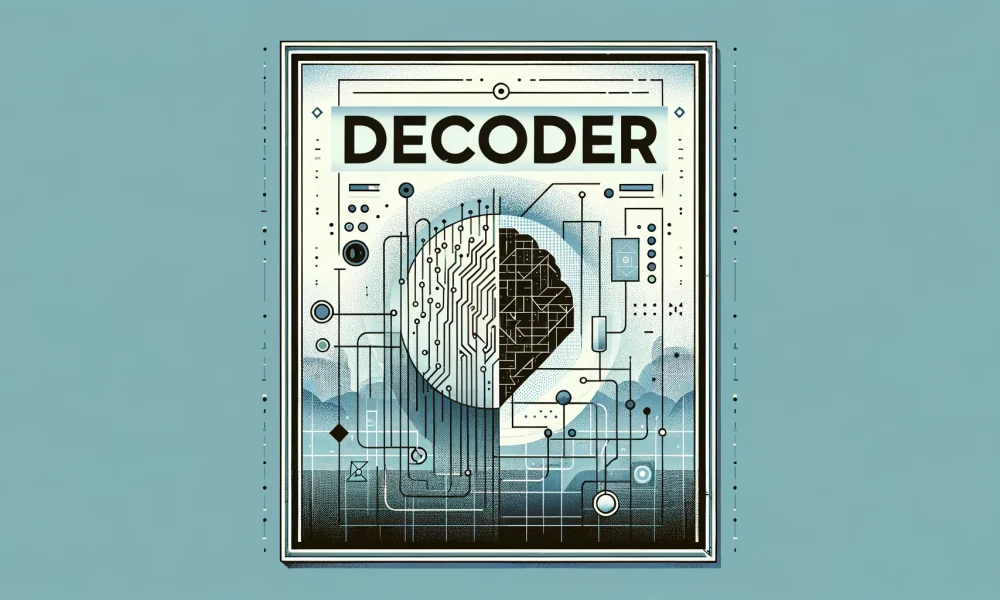Discover the Game-Changing World of Large Language Models
Large Language Models (LLMs) have completely transformed the landscape of natural language processing (NLP) by showcasing extraordinary abilities in creating text that mimics human language, answering questions, and aiding in a variety of language-related tasks. At the heart of these groundbreaking models lies the decoder-only transformer architecture, a variation of the original transformer architecture introduced in the seminal work “Attention is All You Need” by Vaswani et al.
In this in-depth guide, we will delve into the inner workings of decoder-based LLMs, exploring the fundamental components, innovative architecture, and detailed implementation aspects that have positioned these models at the forefront of NLP research and applications.
Revisiting the Transformer Architecture: An Overview
Before delving into the specifics of decoder-based LLMs, it is essential to revisit the transformer architecture, the foundation on which these models are constructed. The transformer introduced a novel approach to sequence modeling, relying on attention mechanisms to capture long-distance dependencies in the data without the need for recurrent or convolutional layers.
The original transformer architecture comprises two primary components: an encoder and a decoder. The encoder processes the input sequence and generates a contextualized representation, which is then consumed by the decoder to produce the output sequence. Initially intended for machine translation tasks, the encoder handles the input sentence in the source language, while the decoder generates the corresponding sentence in the target language.
Self-Attention: The Core of Transformer’s Success
At the core of the transformer lies the self-attention mechanism, a potent technique that enables the model to weigh and aggregate information from various positions in the input sequence. Unlike traditional sequence models that process input tokens sequentially, self-attention allows the model to capture dependencies between any pair of tokens, irrespective of their position in the sequence.
The self-attention operation comprises three main steps:
Query, Key, and Value Projections: The input sequence is projected into three separate representations – queries (Q), keys (K), and values (V) – obtained by multiplying the input with learned weight matrices.
Attention Score Computation: For each position in the input sequence, attention scores are computed by taking the dot product between the corresponding query vector and all key vectors, indicating the relevance…
Weighted Sum of Values: The attention scores are normalized, and the resulting attention weights are used to calculate a weighted sum of the value vectors, generating the output representation for the current position.
Architectural Variants and Configurations
While the fundamental principles of decoder-based LLMs remain consistent, researchers have explored various architectural variants and configurations to enhance performance, efficiency, and generalization capabilities. In this section, we will explore the different architectural choices and their implications.
Architecture Types
Decoder-based LLMs can be broadly categorized into three main types: encoder-decoder, causal decoder, and prefix decoder. Each architecture type displays distinct attention patterns as shown in Figure 1.
Encoder-Decoder Architecture
Built on the vanilla Transformer model, the encoder-decoder architecture comprises two stacks – an encoder and a decoder. The encoder utilizes stacked multi-head self-attention layers to encode the input sequence and generate latent representations. The decoder conducts cross-attention on these representations to generate the target sequence. Effective in various NLP tasks, few LLMs, like Flan-T5, adopt this architecture.
Causal Decoder Architecture
The causal decoder architecture incorporates a unidirectional attention mask, permitting each input token to attend only to past tokens and itself. Both input and output tokens are processed within the same decoder. Leading models like GPT-1, GPT-2, and GPT-3 are built on this architecture, with GPT-3 demonstrating significant in-context learning abilities. Many LLMs, including OPT, BLOOM, and Gopher, have widely embraced causal decoders.
Prefix Decoder Architecture
Also referred to as the non-causal decoder, the prefix decoder architecture adjusts the masking mechanism of causal decoders to enable bidirectional attention over prefix tokens and unidirectional attention on generated tokens. Similar to the encoder-decoder architecture, prefix decoders can encode the prefix sequence bidirectionally and forecast output tokens autoregressively using shared parameters. LLMs based on prefix decoders encompass GLM130B and U-PaLM.
All three architecture types can be extended using the mixture-of-experts (MoE) scaling technique, which sparsely activates a subset of neural network weights for each input. This approach has been utilized in models like Switch Transformer and GLaM, demonstrating significant performance enhancements by increasing the number of experts or total parameter size.
Decoder-Only Transformer: Embracing the Autoregressive Nature
While the original transformer architecture focused on sequence-to-sequence tasks such as machine translation, many NLP tasks, like language modeling and text generation, can be framed as autoregressive problems, where the model generates one token at a time, conditioned on the previously generated tokens.
Enter the decoder-only transformer, a simplified variation of the transformer architecture that retains only the decoder component. This architecture is especially well-suited for autoregressive tasks as it generates output tokens one by one, leveraging the previously generated tokens as input context.
The primary distinction between the decoder-only transformer and the original transformer decoder lies in the self-attention mechanism. In the decoder-only setting, the self-attention operation is adapted to prevent the model from attending to future tokens, a feature known as causality. Achieved through masked self-attention, attention scores corresponding to future positions are set to negative infinity, effectively masking them out during the softmax normalization step.
Architectural Components of Decoder-Based LLMs
While the fundamental principles of self-attention and masked self-attention remain unchanged, contemporary decoder-based LLMs have introduced several architectural innovations to enhance performance, efficiency, and generalization capabilities. Let’s examine some of the key components and techniques employed in state-of-the-art LLMs.
Input Representation
Before processing the input sequence, decoder-based LLMs utilize tokenization and embedding techniques to convert raw text into a numerical representation suitable for the model.
Tokenization: The tokenization process transforms the input text into a sequence of tokens, which could be words, subwords, or even individual characters, depending on the tokenization strategy employed. Popular tokenization techniques include Byte-Pair Encoding (BPE), SentencePiece, and WordPiece, which aim to strike a balance between vocabulary size and representation granularity, enabling the model to handle rare or out-of-vocabulary words effectively.
Token Embeddings: Following tokenization, each token is mapped to a dense vector representation known as a token embedding. These embeddings are learned during the training process and capture semantic and syntactic relationships between tokens.
Positional Embeddings: Transformer models process the entire input sequence simultaneously, lacking the inherent notion of token positions present in recurrent models. To integrate positional information, positional embeddings are added to the token embeddings, allowing the model to differentiate between tokens based on their positions in the sequence. Early LLMs utilized fixed positional embeddings based on sinusoidal functions, while recent models have explored learnable positional embeddings or alternative positional encoding techniques like rotary positional embeddings.
Multi-Head Attention Blocks
The fundamental building blocks of decoder-based LLMs are multi-head attention layers, which execute the masked self-attention operation described earlier. These layers are stacked multiple times, with each layer attending to the output of the preceding layer, enabling the model to capture increasingly complex dependencies and representations.
Attention Heads: Each multi-head attention layer comprises multiple “attention heads,” each with its set of query, key, and value projections. This allows the model to focus on different aspects of the input simultaneously, capturing diverse relationships and patterns.
Residual Connections and Layer Normalization: To facilitate the training of deep networks and address the vanishing gradient problem, decoder-based LLMs incorporate residual connections and layer normalization techniques. Residual connections add the input of a layer to its output, facilitating…
Feed-Forward Layers
In addition to multi-head attention layers, decoder-based LLMs integrate feed-forward layers, applying a simple feed-forward neural network to each position in the sequence. These layers introduce non-linearities and empower the model to learn more intricate representations.
Activation Functions: The choice of activation function in the feed-forward layers can significantly impact the model’s performance. While earlier LLMs employed the widely-used ReLU activation, recent models have adopted more sophisticated activation functions such as the Gaussian Error Linear Unit (GELU) or the SwiGLU activation, demonstrating improved performance.
Sparse Attention and Efficient Transformers
The self-attention mechanism, while powerful, entails a quadratic computational complexity concerning the sequence length, rendering it computationally demanding for extended sequences. To tackle this challenge, several techniques have been proposed to diminish the computational and memory requirements of self-attention, enabling the efficient processing of longer sequences.
Sparse Attention: Sparse attention techniques, like the one applied in the GPT-3 model, selectively attend to a subset of positions in the input sequence instead of computing attention scores for all positions. This can significantly reduce the computational complexity while maintaining performance.
Sliding Window Attention: Introduced in the Mistral 7B model, sliding window attention (SWA) is a straightforward yet effective technique that confines the attention span of each token to a fixed window size. Leveraging the capacity of transformer layers to transmit information across multiple layers, SWA effectively extends the attention span without the quadratic complexity of full self-attention.
Rolling Buffer Cache: To further curtail memory requirements, particularly for lengthy sequences, the Mistral 7B model employs a rolling buffer cache. This technique stores and reuses the computed key and value vectors for a fixed window size, eliminating redundant computations and reducing memory usage.
Grouped Query Attention: Introduced in the LLaMA 2 model, grouped query attention (GQA) presents a variant of the multi-query attention mechanism, dividing attention heads into groups, each sharing a common key and value matrix. This approach strikes a balance between the efficiency of multi-query attention and the performance of standard self-attention, offering improved inference times while upholding high-quality results.
Model Size and Scaling
One of the defining aspects of modern LLMs is their sheer scale, with the number of parameters varying from billions to hundreds of billions. Enhancing the model size has been a pivotal factor in achieving state-of-the-art performance, as larger models can capture more complex patterns and relationships in the data.
Parameter Count: The number of parameters in a decoder-based LLM primarily hinges on the embedding dimension (d_model), the number of attention heads (n_heads), the number of layers (n_layers), and the vocabulary size (vocab_size). For instance, the GPT-3 model entails 175 billion parameters, with d_model = 12288, n_heads = 96, n_layers = 96, and vocab_size = 50257.
Model Parallelism: Training and deploying such colossal models necessitate substantial computational resources and specialized hardware. To surmount this challenge, model parallelism techniques have been employed, where the model is divided across multiple GPUs or TPUs, with each device handling a portion of the computations.
Mixture-of-Experts: Another approach to scaling LLMs is the mixture-of-experts (MoE) architecture, which amalgamates multiple expert models, each specializing in a distinct subset of the data or task. An example of an MoE model is the Mixtral 8x7B model, which utilizes the Mistral 7B as its base model, delivering superior performance while maintaining computational efficiency.
Inference and Text Generation
One of the primary applications of decoder-based LLMs is text generation, where the model creates coherent and natural-sounding text based on a given prompt or context.
Autoregressive Decoding: During inference, decoder-based LLMs generate text in an autoregressive manner, predicting one token at a time based on the preceding tokens and the input prompt. This process continues until a predetermined stopping criterion is met, such as reaching a maximum sequence length or generating an end-of-sequence token.
Sampling Strategies: To generate diverse and realistic text, various sampling strategies can be employed, such as top-k sampling, top-p sampling (nucleus sampling), or temperature scaling. These techniques control the balance between diversity and coherence of the generated text by adjusting the probability distribution over the vocabulary.
Prompt Engineering: The quality and specificity of the input prompt can significantly impact the generated text. Prompt engineering, the practice of crafting effective prompts, has emerged as a critical aspect of leveraging LLMs for diverse tasks, enabling users to steer the model’s generation process and attain desired outputs.
Human-in-the-Loop Decoding: To further enhance the quality and coherence of generated text, techniques like Reinforcement Learning from Human Feedback (RLHF) have been employed. In this approach, human raters provide feedback on the model-generated text, which is then utilized to fine-tune the model, aligning it with human preferences and enhancing its outputs.
Advancements and Future Directions
The realm of decoder-based LLMs is swiftly evolving, with new research and breakthroughs continually expanding the horizons of what these models can accomplish. Here are some notable advancements and potential future directions:
Efficient Transformer Variants: While sparse attention and sliding window attention have made significant strides in enhancing the efficiency of decoder-based LLMs, researchers are actively exploring alternative transformer architectures and attention mechanisms to further reduce computational demands while maintaining or enhancing performance.
Multimodal LLMs: Extending the capabilities of LLMs beyond text, multimodal models seek to integrate multiple modalities, such as images, audio, or video, into a unified framework. This opens up exciting possibilities for applications like image captioning, visual question answering, and multimedia content generation.
Controllable Generation: Enabling fine-grained control over the generated text is a challenging yet crucial direction for LLMs. Techniques like controlled text generation and prompt tuning aim to offer users more granular control over various attributes of the generated text, such as style, tone, or specific content requirements.
Conclusion
Decoder-based LLMs have emerged as a revolutionary force in the realm of natural language processing, pushing the boundaries of language generation and comprehension. From their origins as a simplified variant of the transformer architecture, these models have evolved into advanced and potent systems, leveraging cutting-edge techniques and architectural innovations.
As we continue to explore and advance decoder-based LLMs, we can anticipate witnessing even more remarkable accomplishments in language-related tasks and the integration of these models across a wide spectrum of applications and domains. However, it is crucial to address the ethical considerations, interpretability challenges, and potential biases that may arise from the widespread adoption of these powerful models.
By remaining at the forefront of research, fostering open collaboration, and upholding a strong commitment to responsible AI development, we can unlock the full potential of decoder-based LLMs while ensuring their development and utilization in a safe, ethical, and beneficial manner for society.
Decoder-Based Large Language Models: FAQs
1. What are decoder-based large language models?
Decoder-based large language models are advanced artificial intelligence systems that use decoder networks to generate text based on input data. These models can be trained on vast amounts of text data to develop a deep understanding of language patterns and generate human-like text.
2. How are decoder-based large language models different from other language models?
Decoder-based large language models differ from other language models in that they use decoder networks to generate text, allowing for more complex and nuanced output. These models are also trained on enormous datasets to provide a broader knowledge base for text generation.
3. What applications can benefit from decoder-based large language models?
- Chatbots and virtual assistants
- Content generation for websites and social media
- Language translation services
- Text summarization and analysis
4. How can businesses leverage decoder-based large language models?
Businesses can leverage decoder-based large language models to automate customer interactions, generate personalized content, improve language translation services, and analyze large volumes of text data for insights and trends. These models can help increase efficiency, enhance user experiences, and drive innovation.
5. What are the potential challenges of using decoder-based large language models?
- Data privacy and security concerns
- Ethical considerations related to text generation and manipulation
- Model bias and fairness issues
- Complexity of training and fine-tuning large language models










